Chapter Twelve - Decision-making Under Deep Uncertainty
Published online by Cambridge University Press: 28 February 2024
Summary
“If, to take a somewhat jaundiced view of the situation, we view ourselves as looking for a lost object (the best climate policy) in a dark room, at least we now know the size and shape of the room. With luck, we might even find a flashlight.”
— Legal scholar Daniel FarberDecision-making chooses among alternatives in order to change outcomes in a desired way. Alternatives are problem-dependent and can include policies, strategies, plans, designs, or other actions. Decision analysis supports risk management and policy making. Decision analysis frameworks and tools can provide systematic approaches for organizing the pros and cons of decision alternatives.
Classical decision analysis identifies an optimal choice among actions, based upon the probability of occurrence of possible outcomes and the decision maker's utility functions that measures preferences. Influence diagrams and decision trees are commonly used graphical representations of decision-analysis problems. Quantitative approaches such as Bayesian approaches and expected utility-based perspectives complement more qualitative decision tools. Uncertainties in the input parameters are propagated through a model to generate the expected utility of the different options. Decision rules are then applied (e.g., the maximum expected utility). Classical decision analysis is useful for tame or simple problems.
However, nearly all decisions with high consequences are not simple—rather, they are characterized by complexity, uncertainty, and ambiguity. Examples include climate change, global pandemics, mega-scale infrastructure projects, selection of energy sources to rely on in the future, development of cities, and management of rare events such as a natural disaster, a financial crisis, or a terrorist attack. For a complex decision with the potential for serious consequences, the classical analytical decision tools have severe limitations. But non-simple risks are commonly treated, assessed, and managed as if they were simple. This maltreatment can result in social amplification of the risk, prolonged controversy, conflicts, stalemates, questions of legitimacy, expensive recovery procedures, and commitments that are difficult to adjust.
The examples cited above are associated with “deep uncertainty.” There can be many sources of deep uncertainty in a complex system. Fundamental indeterminacy or unpredictable system outcomes are common conditions of emergent, systemic risks (Section 10.1.2). Decision-making in the face of systemic complexity often faces disagreement about priorities, goals, and values with regards to the desirability of different outcomes. Further, there are irreducible uncertainties regarding the consequences of our actions in the presence of systemic risk.
- Type
- Chapter
- Information
- Climate Uncertainty and RiskRethinking Our Response, pp. 181 - 192Publisher: Anthem PressPrint publication year: 2023



